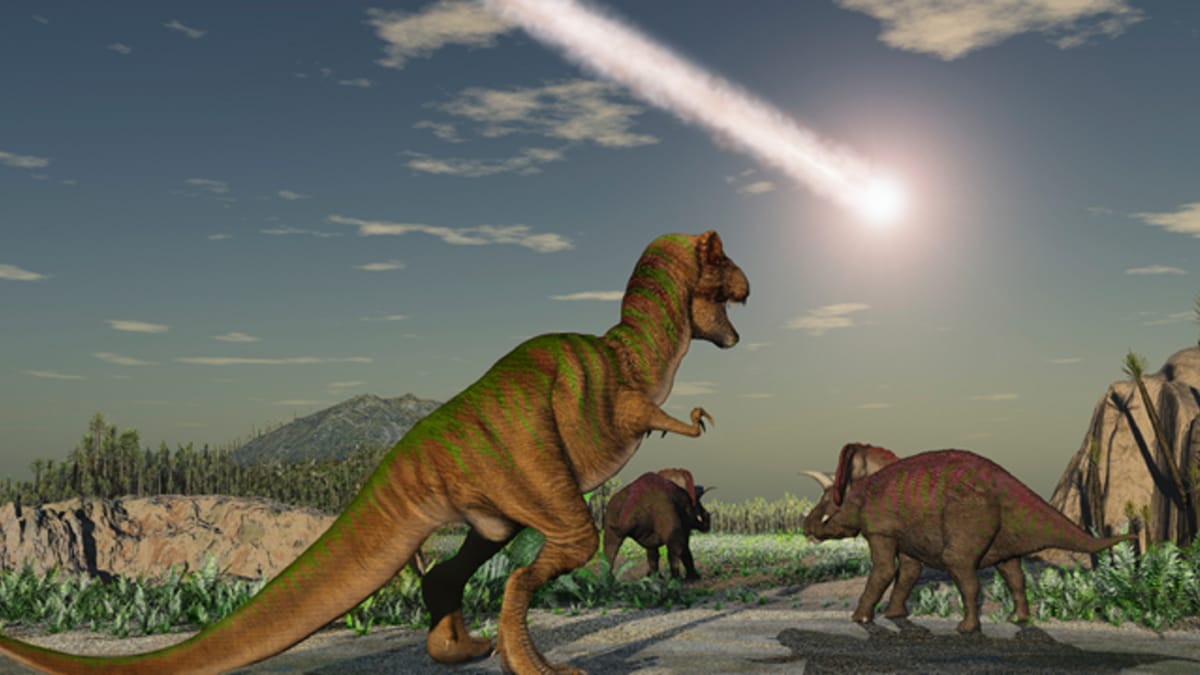Table of Contents
Face it, everyone is fascinated by dinosaurs. We’re also fascinated by catastrophes, as anyone who’s ever seen lines of motorists slowing to rubberneck a car-crash knows. Put the two together and we have the prevailing theory that the dinosaurs were wiped out by a cataclysmic asteroid impact.

Admittedly the evidence for the asteroid-impact hypothesis is pretty compelling. We know that a massive asteroid smashed into Earth at roughly the same time as the dinosaurs disappeared. We also know that the devastating effects of the Chicxulub impact, as it is called, were global.
Yet… there remain anomalies. If a global “nuclear winter” was responsible, why did Antarctic dinosaurs, adapted to cold and darkness, also vanish?
More intriguing, there is good evidence that dinosaurs were on the way out well before the asteroid.
It is widely debated whether dinosaurs were in decline or not before the Chicxulub impact. A study in the journal Nature Communications provides new evidence for an environmentally-driven global decline across dinosaur groups well before the asteroid impact.
“We looked at the six most abundant dinosaur families (Ankylosauridae, Ceratopsidae, Hadrosauridae, Dromaeosauridae, Troodontidae, and Tyrannosauridae) through the whole of the Cretaceous, spanning from 150 to 66 million years ago, and found that they were all evolving and expanding and clearly being successful,” said Dr. Fabien Condamine, a researcher at the Institut des Sciences de l’Evolution de Montpellier and CNRS.
“Then, 76 million years ago, they show a sudden downturn. Their rates of extinction rose and in some cases the rate of origin of new species dropped off.”
When trying to evaluate ancient ecosystems, the most important thing to bear in mind is just how rare fossilisation really is. The fossil record is therefore a necessarily incomplete guide to ancient biodiversity. So it should be cautioned that the study in question is based heavily on computer modelling, with all its limitations.
Dr. Condamine and colleagues used Bayesian modeling techniques to account for several kinds of uncertainties such as incomplete fossil records, uncertainties over age-dating the fossils, and uncertainties about the evolutionary models.
The models were each run millions of times to consider all these possible sources of error and to find whether the analyses would converge on an agreed most probable result.
“In all cases, we found evidence for the decline prior to the bolide impact,” said Dr. Guillaume Guinot, a researcher at the Institut des Sciences de l’Evolution de Montpellier and CNRS.
One of the most startling things I ever heard a science lecturer say was asserting that natural selection does not necessarily lead to increased biodiversity. As she said, this is a counter-intuitive idea, but it remains true: natural selection can lead to decreased biodiversity.
Biodiversity has ebbed and flowed during the history of life on earth. The Cambrian era, for instance, flourished with weird lifeforms and entire genera which later disappeared entirely from the Earth. It has long been suspected that the Cretaceous era was notably less biodiverse than, say, the Jurassic.
“We also looked at how these dinosaur ecosystems functioned, and it became clear that the plant-eating species tended to disappear first, and this made the latest dinosaur ecosystems unstable and liable to collapse if environmental conditions became damaging.”
“We used over 1,600 carefully checked records of dinosaurs through the Cretaceous,” added Professor Phil Currie, a paleontologist at the University of Edmonton[…]The decline in dinosaurs in their last ten million years makes sense, and indeed this is the best-sampled part of their fossil record as our study shows.”
Climate change is a prime suspect in the dinosaur exctinction – not global warming, but global cooling.
“It became clear that there were two main factors, first that overall climates were becoming cooler, and this made life harder for the dinosaurs which likely relied on warm temperatures.”
“Then, the loss of herbivores made the ecosystems unstable and prone to extinction cascade.”
“We also found that the longer-lived dinosaur species were more liable to extinction, perhaps reflecting that they could not adapt to the new conditions on Earth.”
The decline of the giant reptiles left the stage clear for the rise of a group of animals that had lurked in the undergrowth of the dinosaurs for tens of millions of years already.
“The dinosaurs were mostly so huge they probably hardly knew that the furry little mammals were there in the undergrowth.”
Sci-News

Please share this article so that others can discover The BFD









